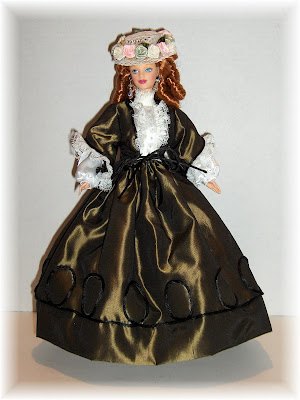Stylish fashion plate circa 1850's
Created by Ana Delia Mercado
The Victorian era corresponds
with the reign of Queen Victoria in England from 1837 to 1901. Her reign of 64 years was remarkably long,
involving different major fashion trends.
With this in mind, I have split this historical narrative into two
parts: Part I corresponds to fashions of
the early Victorian period, from 1837 to 1860.
Part II will focus on the later Victorian years from the 1860’s to
1901.
The period is beloved for its
attention to high morals, modesty, and proper decorum, as inspired by the Queen
and her husband, Prince Albert. It was
an optimistic time in which scientific and industrial invention thrived. During the Victorian era, the precise cut,
material and color of a garment revealed the social class of the wearer. With the growing prosperity of the day,
fashions for women of the higher classes became increasingly complex. The era also saw the progression from
crinoline skirts to hoop skirts and finally to bustle skirts.
Early 1840's
Created by Almudena Gonzalez
In the late 1830’s, Victoria
dressed according to the trends of the day, wearing the full hooped skirts of
what is now referred to as the Romantic Period (1825-1835). In 1840 when she married Prince Albert, of
Germany, his style immediately began to influence her, and ultimately all of
England. Soon her clothing became more
restrained, her skirt lengths dropping to the floor, sleeves diminishing in
size, hats and hairstyles becoming more sedate.

1840's daywear
Created by Ana Delia Mercado

1840's daywear
Created by Ana Delia Mercado
Crinoline underskirts became the
rage in the 1840’s. Lined with stiff,
horsehair cloth, these petticoats were touted as being light and cool, and just
the garment to make a dress sit beautifully.
With fashions now designed to promote the look of respectability, the
shawl and poke bonnet became de rigueur. When a woman wore this deep- brimmed head
covering, her face could be seen when someone only looked directly at her.
An example of a mourning ensemble circa late 1840's
Created by Willem van der Leer
Only at evening events was it socially acceptable for a lady to bare her neck, shoulders, and upper bosom. The only time that a lady was permitted to expose her arms was on formal occasions, and then she usually wore long, fitted gloves or a wrap. Ladies were expected to wear gloves, indoors or out, at all times, except when dining.
Evening wear fashion plate 1847
Created by Judy Frank
For men, the Victorian period was marked by fashions that were formal, elegant and somewhat somber during their work and leisure hours. Clean, basic lines, dark colors and an attention to detail were integral elements. With the exceptions of workmen performing hard labor, men were expected to wear a coat, hat and vest at all times in public. Anything less would have been considered inappropriate and run counter to societal values. One of the most basic elements of the Victorian man's wardrobe was the waistcoat or vest. This piece was considered to be the axis of the ensemble. Vests could be brightly colored or dark and would often be used as an accessory to change the tone of a suit. The same suit could be worn a number of times with different vests, thereby changing the overall appearance. Hats were of equal importance to the Victorian man's ensemble, and there were many popular variations.
Top hats were reserved for more formal occasions, although they were occasionally worn during the day by men of means. Bowler hats or derbies grew increasingly common as the years passed and were considered appropriate day wear. The outerwear of choice for Victorian men was the frock coat – a long coat with a full skirt and a hem that hit above the knees. This garment was worn day or night and was a staple of any Victorian man's wardrobe. Accessories for men included ties (cravats), pocket watches, gloves, and walking sticks.
Victorian Gentleman wearing a morning frock coat circa early 1840's
Created by Willem van der Leer
Daywear ensemble, late 1850's /early 1860's
The model is wearing a stylish straw hat instead of a bonnet
Created by Marcene Burtt
The top two ensembles are perfect examples of the fashions synonymous with the Crinoline - or hooped period - of the Victorian Age
Your comments and feedback are appreciated!








preciosas me ha encantado a cual mas bonita
ReplyDeleteHola Loly! Gracias por los cumplidos....espero pronto sacar la segunda parte...
DeleteWonderful post Damarys! I love reading these tidbits of history, they're fascinating!
ReplyDeleteHello and THANK YOU for your compliments! It pleases me to hear you enjoy reading about fashion history! I truly appreciate your feedback.
Delete